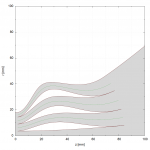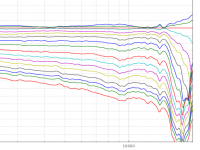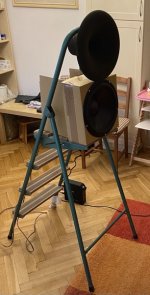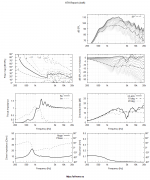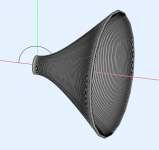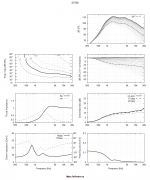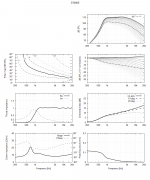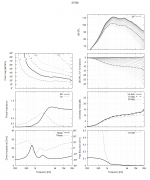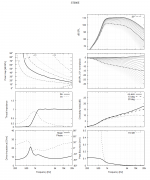Well I still hope that something like this can get pretty close -
(It's actually wrong but it's the best picture I have at hand at the moment.)
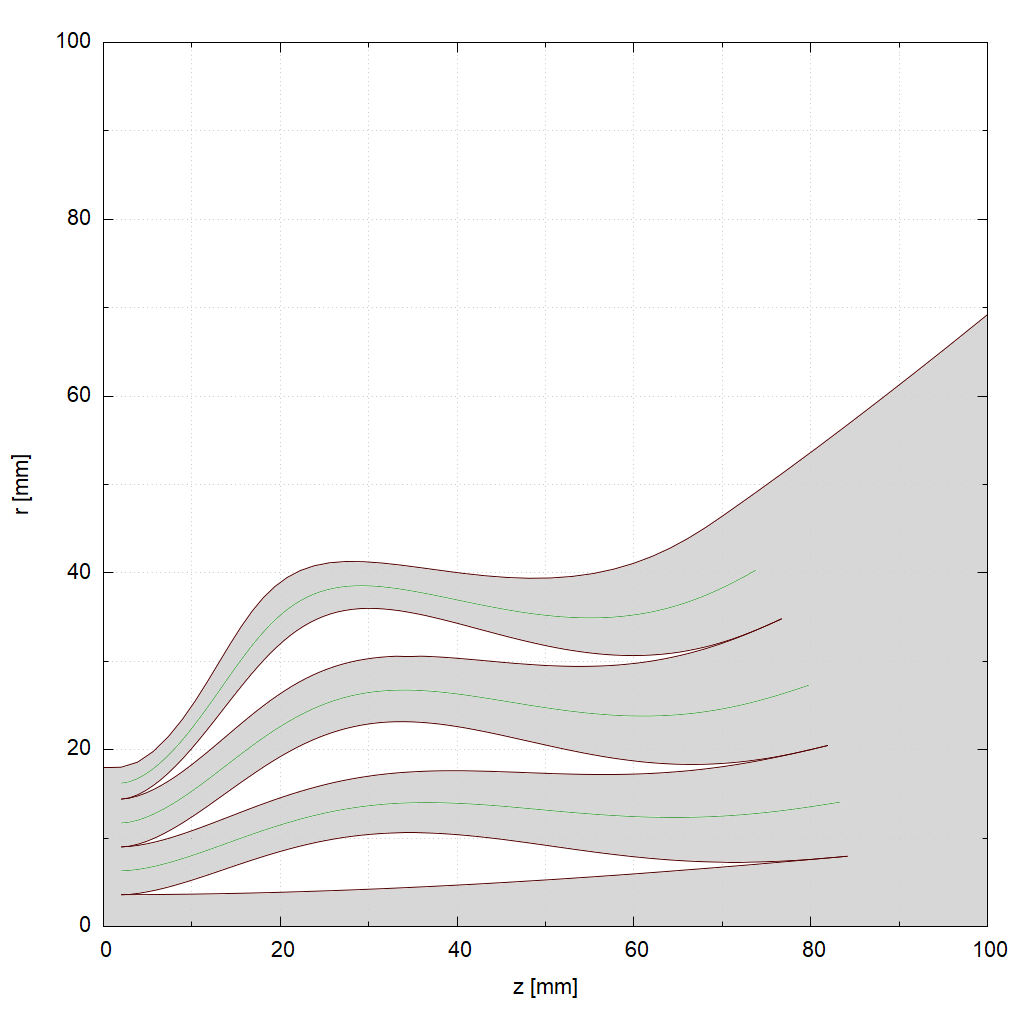
(It's actually wrong but it's the best picture I have at hand at the moment.)
Attachments
Last edited:
Agreed, that is an intriguing idea. I just see implementation rather complex. This is basically a separate phase plug to correct what the existing phase plug gets wrong.
That's the downside of it. The main idea is that even if the input wavefront was perfect (perfectly flat), it should still improve things considerably - at least push the frequency where the radiation pattern collapses, hopefully outside of the audio band. For a 1.4" throat this is around 12 kHz otherwise. For a 2" throat just above 8 kHz - that would make a big difference. If it could increase acoustic load at the same time, perhaps it would make sense even for a 1" throat.
But it's quite possible that the flaws in the phase plug of the driver will spoil the effort completely, I'm aware of that. Maybe this will finally induce me to actually measure the existing wavefront - perhaps it could be corrected for after all, I don't know.
But it's quite possible that the flaws in the phase plug of the driver will spoil the effort completely, I'm aware of that. Maybe this will finally induce me to actually measure the existing wavefront - perhaps it could be corrected for after all, I don't know.
Last edited:
What makes me optimistic is that the modern drivers seem to be pretty good in this regard - see the Sandhorn with Faital HF108 below, for example - the result is pretty close to what the simulation predicts for an ideal wavefront, and if there are deviations, they must be relatively small, i.e. the net possitive effect should be considerably bigger than the differences caused by deviations from the ideal.
(vertical step 2 dB, per 5 deg, courtesy of miero)
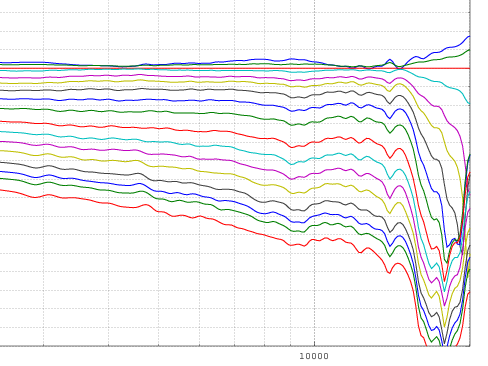
(vertical step 2 dB, per 5 deg, courtesy of miero)
Attachments
Last edited:
Working on a new report including the driver LE model 🙂
Attachments
Last edited:
In the case of the 2" Axi Driver, I'm continuing the existing vanes of the CD's phaseplug.
And agreed with Mabat on that morphing the vanes into a square is more difficult than I initially thought ��
Will probably build an axisymmetric prototype as well.
And agreed with Mabat on that morphing the vanes into a square is more difficult than I initially thought ��
Will probably build an axisymmetric prototype as well.
I already had to start from scratch even for the axisymmetric case 🙂
Not as easy as it seems...
Not as easy as it seems...
Seems you've gone on the mini-multicell into a OS waveguide journey 🙂
It makes a lot of sense and makes it way harder.
Have you tried the Grasshopper plugin for Rhino btw?
It makes a lot of sense and makes it way harder.
Have you tried the Grasshopper plugin for Rhino btw?
No, actually I just gave up that idea. It doesn't fit well with a slower expansion throat - mainly because it's not OS anymore (i.e. when k <> 1). It will require a completely different approach. More on that later.
I know it exists but have never done anything with either of those.Have you tried the Grasshopper plugin for Rhino btw?
Last edited:
The ST260 with the same (generic) driver -Working on a new report including the driver LE model 🙂
Attachments
Last edited:
Yes, lower frequency generation requires more air to be moved and for the same Sd it means higher excursion. Your steep increased need for excursion is not only driven by the fixed physical relation between Sd and SPL but also the contributing fact that the acoustical impedance is dropping, coinciding with the excursion increase - hence a loss of loading or aka. "cut off" ;-D The bigger one keeps it's grip a bit lower.
No?
//
No?
//
Last edited:
Excursion goes up with the input voltage linearly as far as the suspension and motor (Bl) remain linear.In the following two charts I added the peak excursion required to reach 110 dB SPL at 1m on-axis.
(Excursion goes up with the input voltage linearly, is that right?)
The trend for higher power capability compression drivers has also led to suspension designs that limit excursion to prevent diaphragm contact with the phase plug at higher voltages.
I still have to complete the user guide but in the meantime, anyone already interested in using the driver models can think about how to proceed with creating a model for a certain driver.
Below is (the only) one that will come with the Ath package (I think it's what bmc0 created some time ago).
The LE part of the simulation will always be connected to the BEM part via the node DrvGroup=1001 - that should be the exit of the driver, otherwise there are no limitations in complexity of the LE models.
Below is (the only) one that will come with the Ath package (I think it's what bmc0 created some time ago).
The LE part of the simulation will always be connected to the BEM part via the node DrvGroup=1001 - that should be the exit of the driver, otherwise there are no limitations in complexity of the LE models.
Code:
Def_Driver 'Drv1'
dD=44mm
Mms=0.8g
Cms=30e-6m/N
Rms=3.0Ns/m
Bl=7.5Tm
Re=6.3ohm
fre=35kHz ExpoRe=1
Le=0.1mH ExpoLe=0.618
System 'S1'
Driver 'D1' Def='Drv1' Node=1=0=10=20
// Rear volume
Enclosure 'Eb' Node=20
Vb=50cm3 Qb/fo=0.1
// Front volume
Duct 'D1' Node=10=200
dD=44mm Len=0.5mm
// Phase plug (simplification)
Waveguide 'W1' Node=200=300
STh=1.52cm2 dMo=20mm Len=22mm Conical
// Conical section between phase plug and exit
Waveguide 'W2' Node=300=400
dTh=20mm dMo=25.4mm Len=22mm Conical
RadImp 'Throat' Node=400 DrvGroup=1001
Last edited:
Just a remark - I think that the section 'W2' from the above example could or even should be moved to the BEM part (utilizing the Throat.Ext feature).
I'll try to test what difference that makes.
I'll try to test what difference that makes.
- Home
- Loudspeakers
- Multi-Way
- Acoustic Horn Design – The Easy Way (Ath4)
